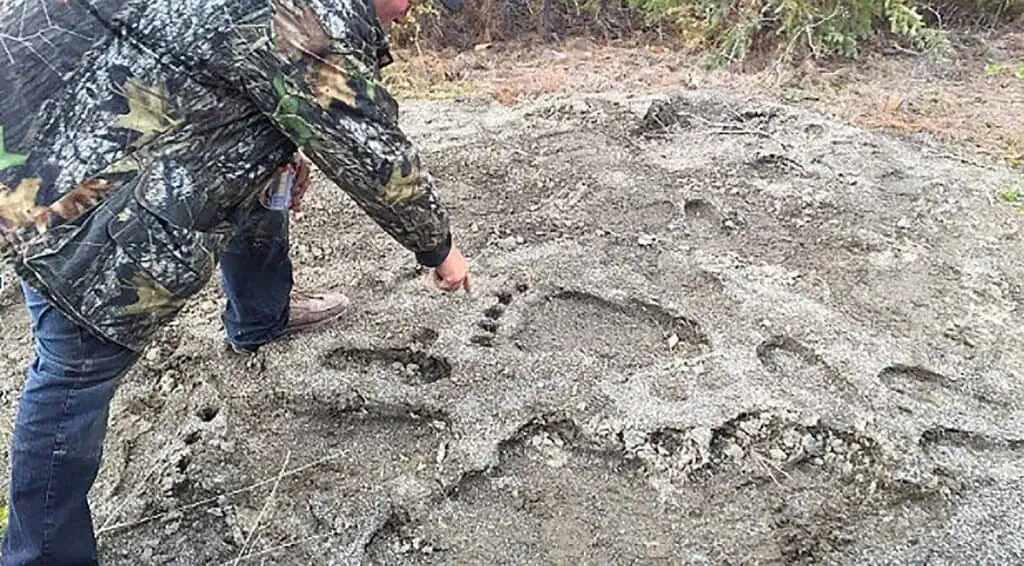
In the fall of 2015, three B.C. hunters decided to hunt in a seldom-used area of northern British Columbia, in a location where the Alaska Highway dips into northern B.C. from Morley Lake to Swift River.
Across Morley Lake is what remains of the Old Alaska Highway, now a mostly 4×4 trail. As that area is seldom, if ever, hunted, our moose hunters from Vancouver figured it would be a good area and decided to hunt around there. So, they set up their campsite in an old gravel pit and hunted the nearby area.
Early in the morning on their third day, they bagged a moose a short distance away from the campsite. While gutting the moose, they noticed a number of large humanlike, bare footprints in the mud. The wife of one of the hunters recognized these large footprints as having been made by a couple of sasquatches, due to the different sizes, and wanted to cast the largest one as a souvenir.
After loading the moose, they drove to Teslin, 60 kilometres away, to get casting material, but none was found, so they decided to drive another 176 kilometres to Whitehorse and get plaster of paris, a material from which they could make a cast. Returning to the kill site, around 6 p.m., they quickly made a slurry mix and poured it onto the largest footprint.
Then they drove back to Teslin for dinner and returned to the location around midnight. The cast had set enough, by then, to be removed. As they were in the process of carefully removing the cast, they were subjected to loud screams, yells and growls—and trees were being thrashed about in the nearby forest.
That really scared them and, no longer feeling safe, they retrieved the cast and quickly piled into the pickup truck and returned to the campsite. However, they decided not to sleep there that night, for safety reasons, so they picked up their gear, left the tent up and drove back to Teslin to spend the night at a motel.
At about 10 a.m. the following day, they went back to the campsite and discovered that their tent and the overall site had been trashed. The tent was shredded and the sleeping bags were torn apart. Everything was scattered about and all of the perishable food was taken. It was a total mess.
They quickly gathered what they could salvage and threw everything in the box of their pickup, next to the moose, and hit the road back to Vancouver, with a 55.88-centimetre-long sasquatch footprint cast as a souvenir.
On October 26, 2015, I received an email from a local newspaper reporter who had received an email from the wife of one of the hunters. It included a photo and a brief description of their experience. I then contacted the lady in question to get the full story, as mentioned above.
I was getting ready to visit the site, but it was snowing by then and I could not get an investigation expedition going … so I waited until the spring of 2016 to start investigating.
In early June, I made my way to the Morley Lake Recreation Area and set up a campsite. I searched for their campsite, which I later found, then searched for the kill site (as it had been described to me). That was a bit more difficult to find, but, finally, after three days of searching, I found a small, grown-in sort of trail that led to the kill site.
There were no signs of any possible sasquatch-related activity found during that expedition, but I didn’t give up and I returned, once again, to the location in 2020.
During the 2020 expedition, I again camped at Morley Lake and operated from there. Returning to the kill site, I found some ground disturbances that were not made by animal hooves but that could have been made by bears (or possibly by our legendary “bushman”).
A footprint cast of 55.88 cemtimetres would indicate that whatever had made the prints had to be some 3.4 metres tall and weigh in the vicinity of 500 kilograms, with a step of 215 centimetres. A footprint of that size is the largest-ever-reported print found in B.C. or in the Yukon, although a footprint of 60 centimetres was reputedly found in the Lake Laberge area, in 1902.




